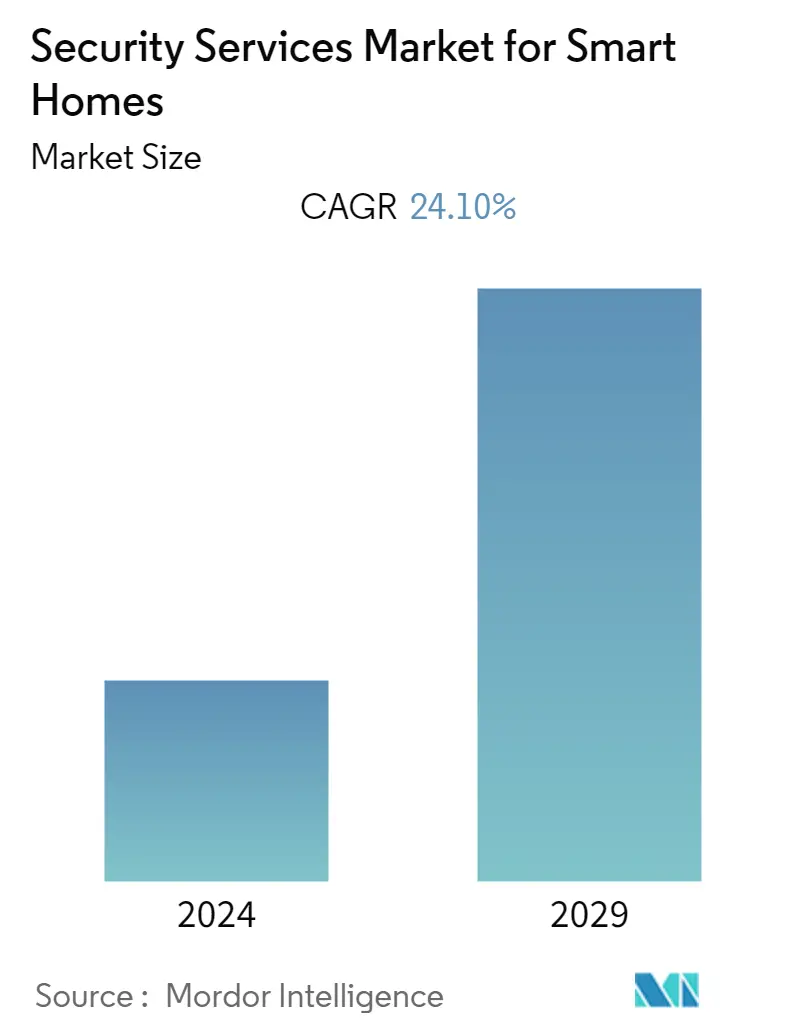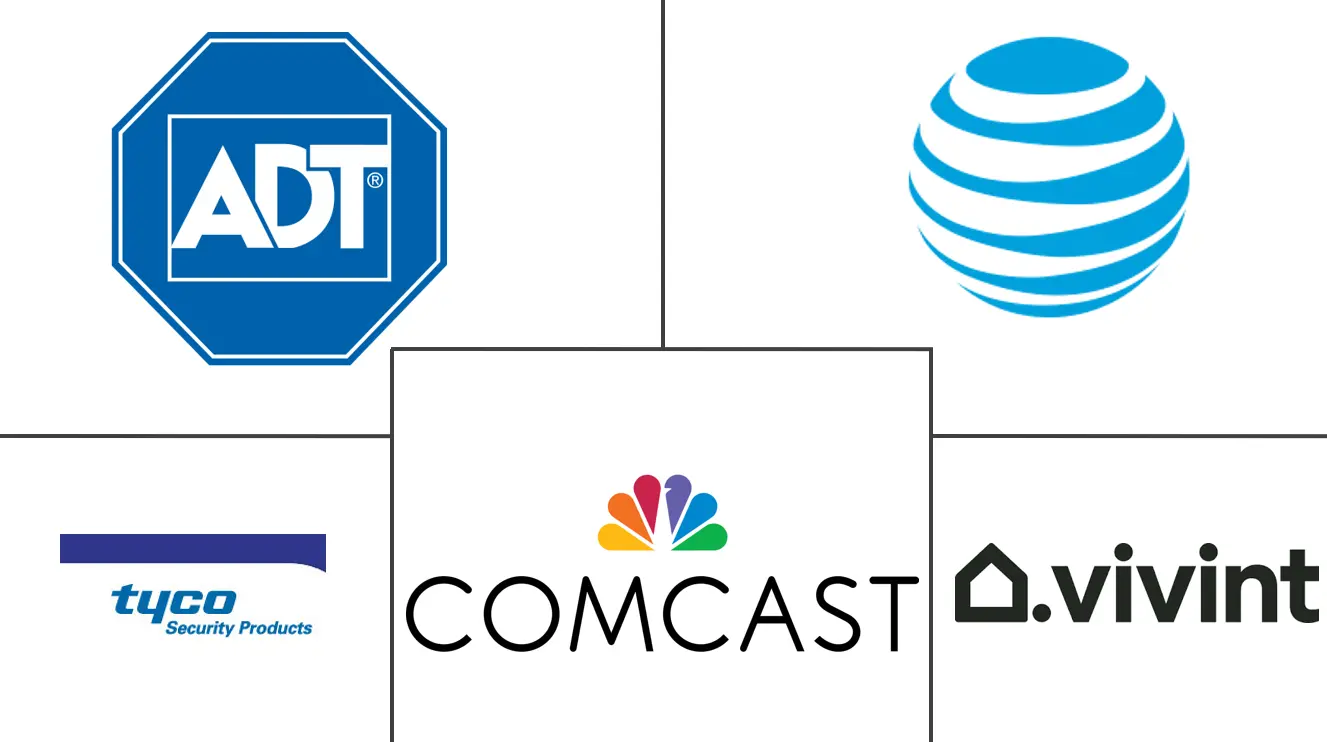Market Size of Security Services Industry for Smart Homes

| Study Period | 2019 - 2029 |
| Base Year For Estimation | 2023 |
| CAGR | 24.10 % |
| Fastest Growing Market | North America |
| Largest Market | North America |
| Market Concentration | Low |
Major Players
*Disclaimer: Major Players sorted in no particular order |
Smart Home Security Services Market Analysis
Security Services Market for Smart Homes is expected to grow at a CAGR of 24.1% over the forecast period (2021 - 2026). The home security system market has been growing at a tremendous rate, with emerging new trends and innovative technologies making the home security sector more effective. The demand for home security systems is likely to be driven by the growing adoption of smart homes, where smart security systems are an integral part. The adoption of smart homes is made possible by the advancement in future technologies like IoT.
Smart home security devices can be connected to Wi-Fi and accessed from anywhere using smart devices, such as smartphones, smartwatches, or voices. The security services market for smart homes is driven by the increasing crime rates across the world, which is forcing people to focus on security and safety systems, especially in residential areas.
Artificial Intelligence (AI) has the potential to play a major role in boosting innovation in the home security and monitoring market. In addition, AI combined with machine learning could reduce the chances of false alarms, enhance detection of anomalous activities and performance of video analytics, and offer better video verification and surveillance capabilities. The introduction of this combination in security and monitoring systems can attract more consumers.
Nowadays, customers prefer multiple solutions in one package to access the most budget-friendly solution. Thus, vendors have been rolling products keeping in mind this kind of demand. For instance, in August 2020, Hero Electronix introduced 'Qubo Shield, a home security solution, which provides end-to-end security across all aspects of the home. It guards against external threats, such as theft or any safety threat, such as fire and gas leakages.
Among all the applications, video surveillance has been gaining the maximum market share. Surveillance systems implemented at homes have varied applications, such as monitoring and access control. These systems are also equipped with features, such as motion detection and night vision. With the increasing rate of crimes, video surveillance is expected to play a significant role in preventing crime, primarily due to the threat of being detected.
COVID-19 has seriously impacted the growth of the security services for the smart home market. The impact of COVID-19 has been significantly adverse, as supply chain disruption in regions such as China has ended in a decline in the need for home security systems. The reduction in the number of latest construction projects and manufacturing plants' closing are determinants influencing the demand globally.
For instance, various home security systems vendors are headquartered in Hubei province, which is one of the pandemic epicenters, thereby affecting domestic vendors such as ZKTeco, Hikvision, and Dahua with labor deficits and production obstructions throughout the country. The coronavirus's impact on the global supply of security equipment has adversely affected the growth of the market.
Smart Home Security Services Industry Segmentation
Security Services for smart homes include Video Surveillance solutions such as Security Cameras, Monitors, and Storage Devices, and Access Control systems such as Facial Recognition, Fingerprint Recognition, and Iris Recognition systems. Smart home security systems also consist of smart home security devices and related services, which comprise solutions such as smart alarms, smart locks, and sensors.
| Product | ||||||
| ||||||
|
| Installation | |
| Professional Installation | |
| Self-installation |
| Geography | ||||||
| ||||||
| ||||||
| ||||||
| ||||||
|
Security Services Market for Smart Homes Size Summary
The smart home security services market is experiencing significant growth, driven by the increasing adoption of smart home technologies and the integration of advanced security systems. The market is characterized by the incorporation of Internet of Things (IoT) technologies, allowing security devices to be connected to Wi-Fi and accessed remotely through smart devices. This trend is further fueled by rising crime rates, prompting a greater focus on residential security solutions. Artificial Intelligence (AI) and machine learning are playing pivotal roles in enhancing the effectiveness of these systems, improving features such as video analytics and anomaly detection. The demand for comprehensive security solutions, which combine multiple functionalities into a single package, is also on the rise, with companies like Hero Electronix and Arlo introducing innovative products to meet consumer needs.
The market landscape is competitive and fragmented, with numerous established and emerging players vying for market share. Video surveillance systems, including IP cameras and wireless options, are gaining prominence due to their affordability and ease of installation. The COVID-19 pandemic has posed challenges, disrupting supply chains and affecting production, particularly in regions like China. However, advancements in technology have led to improved camera quality and reduced costs, driving the adoption of security cameras. Companies are also expanding their offerings through strategic mergers and acquisitions, as seen with Telus Corp's acquisition of ADT Inc.'s local operations. The market is expected to continue evolving, with a focus on integrating smart home technologies to enhance security and energy efficiency.
Security Services Market for Smart Homes Market Size - Table of Contents
-
1. MARKET INSIGHTS
-
1.1 Market Overview
-
1.2 Value Chain Analysis
-
1.3 Porter's Five Forces Analysis
-
1.3.1 Threat of New Entrants
-
1.3.2 Bargaining Power of Buyers
-
1.3.3 Bargaining Power of Suppliers
-
1.3.4 Threat of Substitutes
-
1.3.5 Intensity of Competitive Rivalry
-
-
1.4 Assessment of the Impact of COVID-19 on the Market
-
-
2. MARKET SEGMENTATION
-
2.1 Product
-
2.1.1 Video Surveillance
-
2.1.1.1 Security Cameras
-
2.1.1.2 Monitors
-
2.1.1.3 Storage Devices
-
2.1.1.4 Others
-
-
2.1.2 Access Control
-
2.1.2.1 Facial Recognition
-
2.1.2.2 Fingerprint Recognition
-
2.1.2.3 Iris Recognition
-
2.1.2.4 Others
-
-
-
2.2 Installation
-
2.2.1 Professional Installation
-
2.2.2 Self-installation
-
-
2.3 Geography
-
2.3.1 North America
-
2.3.1.1 United States
-
2.3.1.2 Canada
-
-
2.3.2 Europe
-
2.3.2.1 United Kingdom
-
2.3.2.2 Germany
-
2.3.2.3 France
-
2.3.2.4 Rest of Europe
-
-
2.3.3 Asia Pacific
-
2.3.3.1 China
-
2.3.3.2 Japan
-
2.3.3.3 India
-
2.3.3.4 Rest of Asia Pacific
-
-
2.3.4 Middle East and Africa
-
2.3.4.1 Saudi Arabia
-
2.3.4.2 United Arab Emirates
-
2.3.4.3 Rest of Middle East and Africa
-
-
2.3.5 Latin America
-
2.3.5.1 Brazil
-
2.3.5.2 Mexico
-
2.3.5.3 Rest of Latin America
-
-
-
Security Services Market for Smart Homes Market Size FAQs
What is the current Smart Homes Security Services Market size?
The Smart Homes Security Services Market is projected to register a CAGR of 24.10% during the forecast period (2024-2029)
Who are the key players in Smart Homes Security Services Market?
ADT Security Services, AT&T Inc, Comcast Corporation, Vivint, Inc. and Tyco Security Products are the major companies operating in the Smart Homes Security Services Market.

